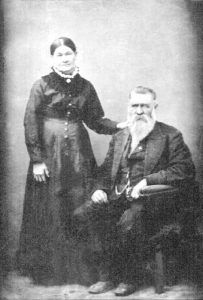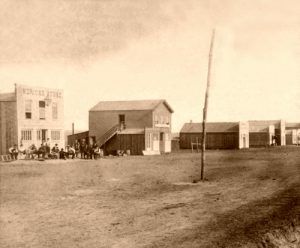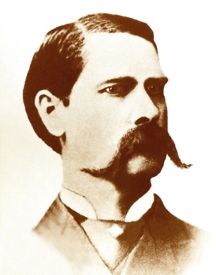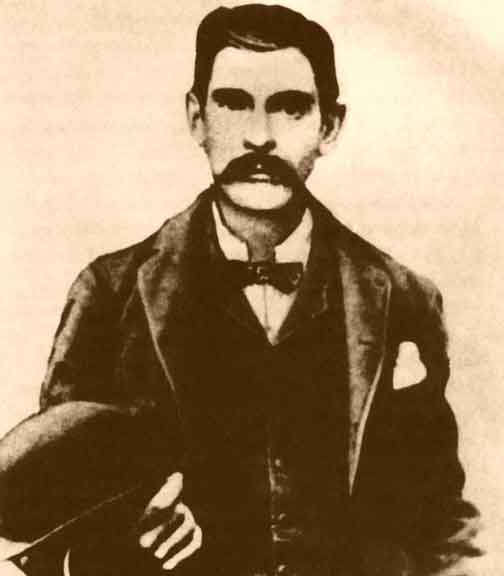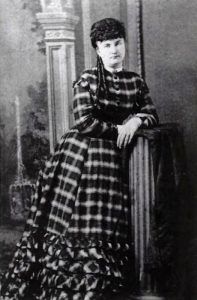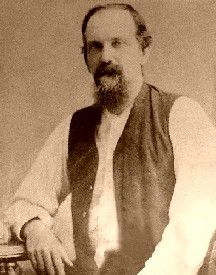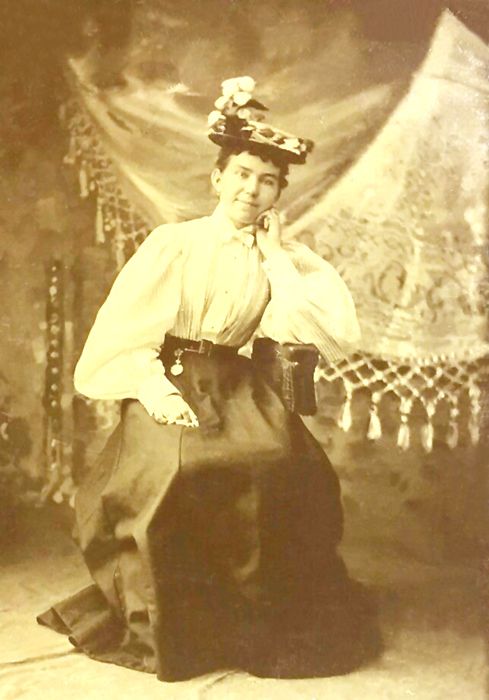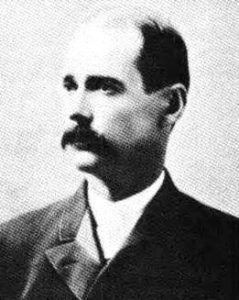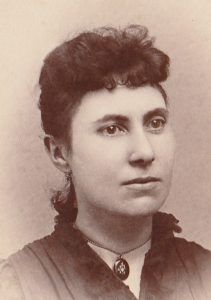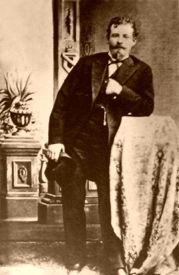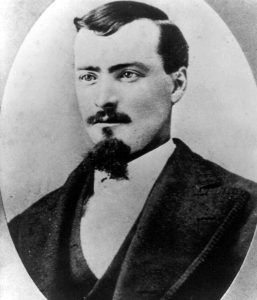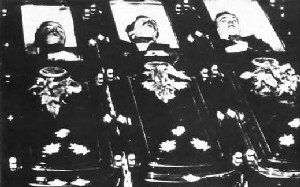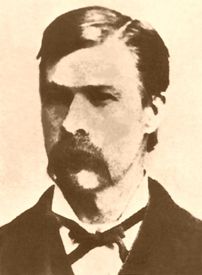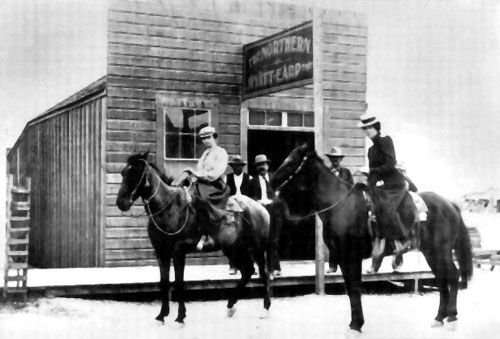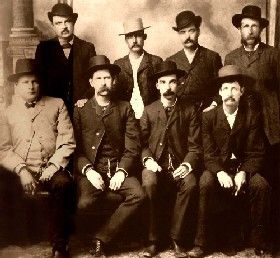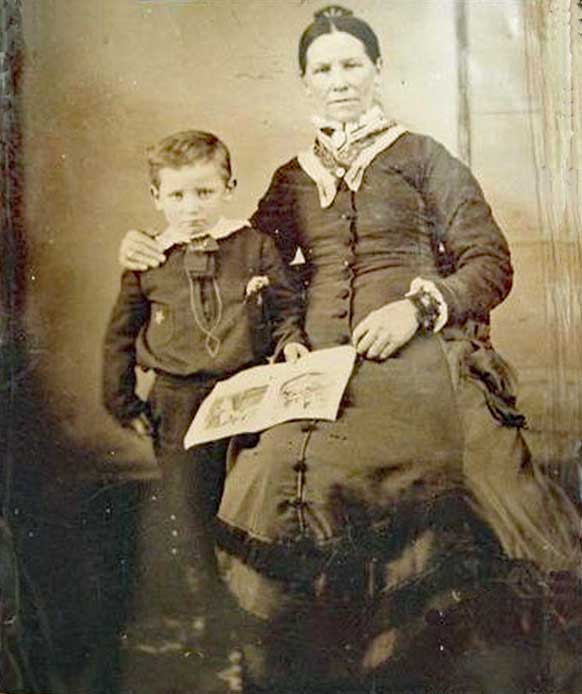
Wyatt Earp with his mother circa 1856.
Wyatt Earp is the best-known frontier lawman of the American West. Soft-spoken with nerves of steel, he survived countless gunfights due to his extraordinary patience and resolute manner. But Earp wasn’t just the famous lawman of Dodge City and Tombstone fame; he was also a buffalo hunter, miner, card dealer, stagecoach driver, saloon owner, and much more throughout the years.
Wyatt Berry Stapp Earp was born to Nicholas Earp and Virginia Earp in Monmouth, Illinois, on March 19, 1848. His father was a lawyer and a farmer who had formerly served in the Army. The would-be lawman was named for his father’s former Army captain. When Wyatt came along, older brothers James and Virgil were seven and five. He also had an older sister named Martha, who was three.
Two years later, the family moved to Iowa, where Nicholas established a farm. Soon, three more siblings would join the rapidly growing family—Morgan in 1851, Warren in 1855, and Adelia in 1861. Nicholas Earp always had high regard for the land and the law, instilling in his children the same respect.
In 1864, the family moved to Colton, California, near San Bernardino. Along the way, Wyatt was given his first weapon—a combination shotgun and rifle—to help protect the family against attacking Indians. Young Wyatt soon acquired a six-gun and practiced daily, becoming a deadly marksman.
When he arrived in California, he worked as a teamster and a railroad worker for a time. But soon, he began to work his way back east as a buffalo hunter, wagon train scout, and railroad hand.
By 1870, Wyatt had worked his way to Lamar, Missouri, where he fell in love and married Urilla Sutherland. However, their time together was brief: Urilla died within a year of marriage. Historical facts vary regarding the cause of her death – some say she died in childbirth, while others indicate that she died of typhoid fever.
Heartbroken, Wyatt headed to Indian Territory (now Oklahoma), working as a buffalo hunter and stagecoach driver. However, he and two travel companions were soon accused of stealing horses. Paying his bail, Wyatt fled to Kansas before the case ever came to trial.
In 1871, Earp met Wild Bill Hickok in Kansas City, Missouri, and other Western legends, including “Buffalo Bill” Cody, Jack Gallagher, and Billy Dixon. Wyatt would later say of Wild Bill Hickok, “Bill Hickok was regarded as the deadliest pistol shot alive and a man of great courage. The truth of certain stories of Bill’s achievements may have been open to debate, but he had earned the respect paid to him.” Wild Bill helped Wyatt become a better buffalo hunter, and Wyatt met Bat Masterson on the open Kansas prairie.
In August 1873, Wyatt was in Ellsworth, Kansas, where the Earp legend began. Ellsworth, a railhead where vast herds of cattle were driven north from Texas, was wild with drunken cowboys, two of whom were Billy and Ben Thompson, lethal gunmen who would rather resort to gunplay than talk out an argument.
Wyatt had heard of the two killers and chose not to play with the unpredictable men at the same gaming tables. But before long, he caught up with them on August 15, 1873. While Earp was standing across the street from Brennan’s Saloon, he heard the sounds of an argument coming from the gambling house. The Thompsons had started a dispute with two other gamblers, John Sterling and Jack Morco, a local lawman. The disturbance soon brought Sheriff Chauncey B. Whitney and two deputies.
Sterling and Morco charged at the Thompsons, guns blazing, but Ben Ben Thompson drove them off with a volley of shots. Then, Billy Thompson, a homicidal maniac and hopeless alcoholic, turned his gun on Sheriff Whitney, a drinking companion and friend to the two brothers before this. At point-blank range, he shot the sheriff down.
Wyatt watched the events without interfering as he saw Ellsworth Mayor James Miller enter the saloon and demand that Thompson surrender his guns. When Thompson refused, Miller searched for Whitney’s deputies, who had disappeared from the scene after the sheriff was shot.
Dismayed when Wyatt spotted the two deputies cowering on the sidelines, he remarked to the passing Mayor Miller, “It’s none of my business, but if it were me, I’d get me a gun and arrest Ben Thompson or kill him.” Miller tore the badge off Deputy Norton’s chest and, walking back to Earp, said: “I’ll make it your business.”
Wyatt watched, stunned, as Ben Thompson swaggered out of the saloon and mounted his horse, as brother Ben waved him goodbye. “What kind of a town is this?” he snapped at the deputies and mayor, who now stood meekly across the square.
Borrowing a pair of six-shooters, he followed Ben Thompson, who was about a block away. When he caught up with him, he demanded that Thompson throw down his gun. Thompson, who knew of Earp, complied, and Wyatt marched him to jail. Ben Thompson was fined $25 for disturbing the peace, and a warrant for murder was issued for his brother Bill.
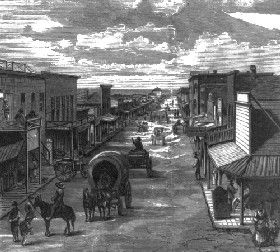
Wichita, Kansas 1874.
Mayor Miller was so impressed that he offered Wyatt the job of town marshal at $125.00 a month. But Earp declined, handing Miller back the badge and saying he intended to go into the cattle business with his brothers.
Ben Thompson, who would later turn lawman himself, would say to Bat Masterson in subsequent years that he had a powerful hunch that Wyatt would have killed him if he hadn’t thrown down his gun. The story of how Earp had backed down Ben Thompson soon spread up and down the Chisholm Trail, and the Wyatt Earp legend was born.
In the spring of 1874, Wyatt moved to Wichita, Kansas, another Wild West town. There, he worked as a part-time lawman and city maintenance man, making about $60.00 monthly. However, he was fired from the police force after fighting with William Smith, who was running for city marshal, against Mike Meagher, a friend of Wyatt’s.
Furthermore, Wyatt was almost arrested himself for discharging his weapon in public. Though the incident was an accident, it didn’t speak well of a lawman. When he was sitting in a local saloon with his feet up on a table, his pistol fell out of its holster and hit the floor, and the gun went off. The bullet went through his coat and into the wall. Before moving to Dodge City, Wyatt and his brother, James, were almost arrested for vagrancy. Some reports say that Wyatt stole city tax money before hightailing it to Dodge.
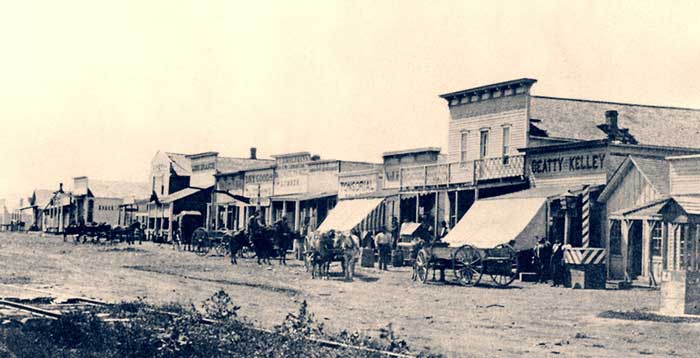
Dodge City, circa 1875.
By the spring of 1876, the cattle trade had shifted west to Dodge City, and soon, Dodge City’s mayor offered Wyatt the position of chief deputy marshal.
Dodge City had already acquired its infamous stamp of lawlessness and gunslinging in the burgeoning settlement. As many buffalo hunters, railroad workers, drifters, and soldiers streamed into the town after long excursions on the prairie, they quickly found the many saloons, gambling houses, and brothels in the lawless town. Inevitably, gunfights were common, and the people of Dodge feared for their lives.
Marshal Larry Deger, the last of a long line of officers who had been run out of town or shot in the back by the lawless forces of Dodge, was overwhelmed and heartily welcomed Wyatt. Soon, four assistant deputies were hired — Bat Masterson, Wyatt’s old buffalo hunting friend; Charlie Bassett; Bill Tilghman; and Neal Brown.
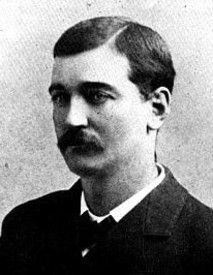
Bat Masterson.
Intending to restore order, the new lawmen first initiated a “Deadline” north of the railroad yards on Front Street to keep the commercial part of the city quiet. On the north side, the city passed an ordinance that guns could not be worn or carried. On the south side of the “deadline,” those who supported the lawlessness continued to operate as usual, with a host of saloons, brothels, and frequent gunfights. The gun-toting rule was in effect around the clock, and anyone wearing a gun was immediately jailed. Soon, Dodge City’s jail was filled.
Earp would go after famed train robber Dave Rudabaugh in his new role, following the outlaw’s trail for 400 miles to Fort Griffin, Texas. When he arrived, Wyatt went first to the largest saloon in town, Shanssey’s, asking about Rudabaugh. Owner John Shanssey said that Rudabaugh had been there earlier in the week but didn’t know where he was bound. He directed Wyatt to Doc Holliday, who had played cards with Rudabaugh.
Wyatt was skeptical about talking to Holliday, as it was well-known that Doc hated lawmen. However, when Wyatt found him that evening at Shanssey’s, he was surprised at Holliday’s willingness to talk. Doc told Wyatt that he thought that Rudabaugh had back-traveled to Kansas. Wyatt wired this information to Bat Masterson, Sheriff in Dodge City, and the news was instrumental in apprehending Rudabaugh. The unlikely pair formed a friendship in Shanssey’s that would last for years.
In the fall of 1876, Wyatt and his brother Morgan left Dodge for a while, traveling for the Black Hills outside of Deadwood, South Dakota, in search of gold. However, he returned to Dodge in May of 1877 after James H. “Dog” Kelley, Dodge City’s new mayor, wired him, asking him to help with the Texas cowboys shooting up the town.
Wyatt was made the new town marshal when he returned and deputized his brother, R Morgan. He began to petition the courts for harsher sentences, banned some men from entering the town, and organized a citizen committee to help law enforcers watch the streets.
Not long after Wyatt returned to Dodge, Doc Holliday turned up with “Big Nose” Kate. After killing a man in Fort Griffin, Texas, Doc was running from a lynching party. At first, Doc hung out his doctor’s shingle but soon went back to gambling, frequenting the Alhambra, and dealing cards at the Long Branch Saloon. Though Dodge City citizens thought the friendship between Wyatt and Doc was strange, Wyatt ignored them, and Doc kept the law while in Dodge City.
“Dodge City is a wicked little town. Indeed, its character is so clearly and egregiously bad that one might conclude, were the evidence in these later times positive of its possibility, that it was marked for special Providential punishment.”
— Washington, D. C., Evening Star, January 1, 1878
While Doc was dealing Faro in the Long Branch Saloon one night, several Texas cowboys arrived with a herd of cattle. After many weeks on the trail, the rowdy cowboys were ready to “let loose.”
Leading the cowboy mob was Ed Morrison, whom Wyatt had humiliated in Wichita, Kansas, and a man named Tobe Driskill. The cowboys rushed the town, galloping down Front Street with guns blazing and blowing out shop windows. Entering the Long Branch Saloon, they began harassing the customers.
When Wyatt entered the front door, he came face to face with several awaiting gun barrels. Stepping forward, Morrison sneered, “Pray and jerk your gun! Your time has come, Earp!”
Suddenly, a voice sounded behind Morrison. “No, friend, you draw – or throw your hands up!” It was Doc, his revolver to Morrison’s temple. Doc had been in the back room, his card game interrupted by the havoc out front.
“Any of you bastards pulls a gun, and your leader here loses what’s left of his brains!” The cowboys dropped their arms. Wyatt rapped Morrison over the head with his long-barreled Colt, then, relieving Driskill and Morrison of their arms, he ushered them to the Dodge City Jail. Wyatt never forgot that Doc Holliday saved his life that night in Dodge City. Responding later, Wyatt said. “The only way anyone could have appreciated the feeling I had for Doc after the Driskill-Morrison business would have been to have stood in my boots when Doc came through the Long Branch doorway.”
While in Dodge City, Wyatt met a saloon girl named Celia Anne Blalock, whom he affectionately called “Mattie.” Though the two never married, they lived as husband and wife. At first, the couple was happy, but Mattie had acquired a laudanum dependency due to a prior illness, which would soon strain their relationship.
Later, in their ongoing love-hate relationship, Big Nose Kate and Doc Holliday had one of their frequent, violent quarrels. Holliday soon saddled his horse and headed to Colorado, leaving Big Nose Kate behind.
An often-written event was the 1878 “showdown” between Wyatt Earp and Clay Allison, the self-proclaimed “shootist” from New Mexico. According to the stories, Allison planned to protest the treatment of his men by the Dodge City marshals and was willing to back his arguments with gun smoke. The Dodge City lawmen had gained a reputation for being hard on visiting cattle herders, with stories circulating that cattlemen had been robbed, shot, and beaten with revolvers. George Hoyt, who had once worked for Clay Allison, had been shot to death while shooting a pistol in the air in the streets of Dodge City.
There are several versions of the story of the showdown. Some say that Allison and his men terrorized Dodge City, while Wyatt Earp and Bat Masterson fled in fear. Others say that Wyatt Earp pressured Allison into leaving. And yet others say that Allison was talked into leaving by a saloon keeper and another cattleman, with little or no contact with Wyatt Earp.
In any case, there is no evidence of any serious altercation ever having happened. Historians surmise that Allison might have come to Dodge City looking for trouble, but nothing happened. While Allison and his men went from saloon to saloon, fortifying themselves with whiskey, Earp and his marshals began to assemble their forces. But in the end, Dick McNulty, owner of a large cattle outfit, and Chalk Beeson, co-owner of the Long Branch Saloon, intervened on behalf of the town, talking the gang into giving up their guns.
By 1879, Dodge City had been tamed, and Wyatt was spending more time at the gaming tables than he was marshaling. So, when brother Virgil wrote him about the new city of Tombstone, Arizona, Wyatt, along with brothers James and Morgan and common-law wife Mattie, headed West. Big Nose Kate would follow, and when Doc Holliday returned to Dodge City and found everyone gone, he, too, headed to Arizona.
Tombstone
When Wyatt arrived in Tombstone in December of 1879, he planned to establish a stage line but soon discovered two were already in the town. Instead, he acquired the gambling concession at the Oriental Saloon for a quarter percent of the proceeds. He also took a side job as a shotgun rider on the stage lines for Wells Fargo shipments. James established a saloon on Allen Street. Virgil Earp was already deputy marshal of Tombstone, and Morgan went to work with his brother as a lawman. Doc Holliday met up with Big Nose Kate in Prescott, Arizona, and the pair soon joined the Earps in Tombstone.
Tombstone was the last of the wide-open hellholes, teaming with rustlers, thieves, gunmen, gamblers, and prostitutes. The outlaw Clanton Gang had been running roughshod over the territory and immediately resented the Earps’ arrival. “Old man” Clanton, his sons, Ike, Phin, and Billy; the McLaury brothers, Frank and Tom; Curly Bill Brocius, John Ringo, and their followers lost no time in expressing their displeasure.
The Clantons had long been rustling cattle from Old Mexico, moving their plunder northward to their ranch on the San Pedro River. Keeping Cochise County Sheriff John Behan on their payroll, their operation was highly successful until the Earps arrived.
Wyatt wasn’t spending all his time working, as he met Josephine “Josie” Sarah Marcus in Tombstone. The petite 18-year-old woman arrived in Tombstone with a traveling theatre troupe in 1879 before Wyatt arrived. She hooked up with Sheriff John Behan and stayed in Tombstone.
However, shortly after Wyatt appeared on the scene, Sheriff Behan made the mistake of introducing Josie to Wyatt, and the two instantly hit it off. The relationship between Wyatt and Mattie continued to deteriorate as Mattie’s laudanum dependency grew worse. Josie thought that Wyatt was the best-looking man in Tombstone, and she began to be seen with him almost every night at his faro table while Mattie lingered at home.
Behan refused to accept Josie’s apologies and fell in deeper with the Clantons to thwart the Earps at every turn. Now holding a personal grudge, he vowed to help the rustlers rid Tombstone of the bothersome Earp brothers as soon as possible.
So, when, in July 1880, John Behan offered him a job as deputy sheriff under Chief Marshal Fred White, he was suspicious. Wyatt finally concluded that the offer was designed to keep him too busy to guard the Wells Fargo stage, again allowing the Clantons access to this lucrative plunder. Wyatt accepted the job, but Behan’s plan failed when Wyatt convinced Wells Fargo to hire his brother, Morgan, as the new guard in his place. Their plan having been a “bust,” the Clantons were furious.
Curly Bill Brocius first tangled with Wyatt Earp in October 1880. One day, Brocius, along with Billy Clanton and Frank and Tom McLaury, were riding up and down Allen Street, firing their weapons and harassing anyone walking along the boardwalks. When Sheriff White tried to stop the cowboys, Brocius drew his gun. White grabbed it, and in the fray, the gun went off, hitting White in the groin.
Earp arrived on the scene and brought his six-gun down on Curly Bill’s head, knocking him unconscious. White was taken to the doctor, and Brocius was taken to jail.
White made a deathbed statement in the doctor’s office that his carelessness had shot him. After White’s death, Wyatt confronted the gunmen, stating he would kill any one of them who reached for a weapon and ordered them out of town. Soon, Curly Bill was released, thanks to White’s dying statement.
Meanwhile, while Doc Holliday gambled at the Oriental Saloon, John Behan accused Doc of manipulating a faro game. Doc, never one to back down, quickly challenged Behan, who retreated hastily. Behan’s public embarrassment added more fuel to the fire.
Through the early months of 1881, the Clantons continued to rustle cattle from Mexico, a crime that the Earp lawmen could do nothing about. Their hands were tied since cattle rustling was officially a county matter, and John Behan was the county. The gap between the law and the outlaw faction grew wider, dividing the town into two camps. While most of Tombstone’s citizens supported the Earps, the politically strong outlaw element, with Behan in control, supported the Clantons.
In the meantime, Doc and “Big Nose” Kate continued living together, but they had serious arguments when Kate got drunk. Her drunkenness often escalated to abuse, and finally, Doc had had enough and threw her out. The Clantons used this separation to their advantage.
On March 15, 1881, four masked men attempted a hold-up on a stagecoach near Contention and, in the attempt, killed the stage driver and a passenger. The Cowboy faction immediately seized the opportunity and accused Doc Holliday of being one of the holdup men. Investigating the holdup, Sheriff Behan found Kate on one of her drunken binges, still berating Doc for throwing her out. After feeding her even more whiskey, Behan persuaded her to sign an affidavit that Doc had been one of the masked highwaymen and killed the stage driver.
While Kate was sobering up, the Earps were rounding up witnesses who could verify Doc’s whereabouts on the night in question. When Kate realized what she had done, she repudiated her statement, and the charges were thrown out. But, for Doc, this was the “last straw” for Kate, and by giving her some money, he put her on a stage out of town.
Wyatt and his deputies had gone after the robbers, for that matter, and had arrested a Clanton hanger-on named Luther King, who, under pressure, had confessed to participating in the crime. But, after the arrest, John Behan argued that King was his prisoner since the crime was territorial, not city. Suspiciously, King escaped from Behan’s jail. It was then apparent to Wyatt that Doc had been shanghaied as an intended sacrificial lamb and that King was released so as not to implicate the real perpetrators of the holdup.
Events, a piece at a time, now moved rapidly toward a final showdown. Old Man Clanton was shot and killed by a band of vaqueros during a rustling attempt below the border; his eldest son Ike, whose rushed judgments would prove fatal, took the family reins. Also, in the heat of summer 1881, a fire swept the business district of Tombstone, and the citizens blamed Marshall Ben Sippy for not controlling the looting that followed; Virgil Earp, the senior deputy, was appointed a marshal, a move that antagonized the already-hostile Clantons. And, of course, there was Josie, who continued to see Wyatt. While she tried to remain apart from the bad blood churning between the factions, the sight of her riled Behan all over again. Throughout the lazy summer season of 1881, threats against the Earp brothers increased. Ike Clanton, Johnny Ringo, “Curly Bill” Brocius, and others of their ilk often told a barroom full how they would send Wyatt Earp to Boot Hill.
Gunfight at the OK Corral
On Tuesday, October 25, Ike Clanton spent the day getting drunk, moving from one saloon to the next, and making threats against the Earps and Holliday to any who would listen. That night, he went to the Occidental Saloon for a card game with Tom McLaury.
An angry Doc Holliday, who had heard of the boasts, confronted him. “I heard you’re going to kill me, Ike,” he said. “Get out your gun and commence.” Virgil, a U.S. Deputy Marshal, Wyatt, an appointed acting city marshal by Virgil, and Morgan, also a sworn officer, were present during this confrontation. Virgil told Doc and Ike that he would arrest both of them if they continued the argument.
Though boasting violence throughout the day, Clanton was unarmed, and finally, Virgil drew Holliday away. But Clanton followed, promising “to kill you tomorrow when the others come to town.”
Spotting Wyatt on the streets, the fired-up Clanton continued. “Tell your consumptive friend, your Arizona nightin’gale; he’s a dead man tomorrow!” To which Wyatt just turned and replied: “Don’t you tangle with Doc Holliday — he’ll kill you before you’ve begun.”
Ike’s parting shot was, “Get ready for a showdown!”
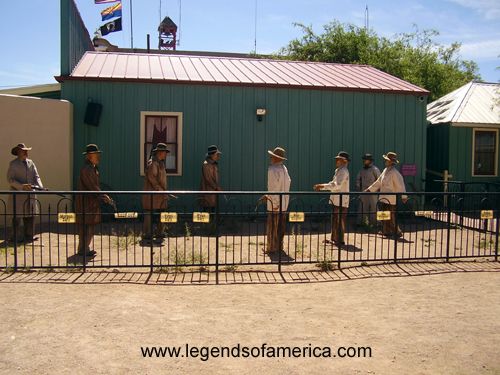
Re-creation of the Gunfight at the O.K. Corral.
Wednesday, October 26, 1881, was an overcast, windy day. The Earps, in anticipation of trouble, woke early. As Virgil watched from his hotel window, he saw Billy Clanton ride into town, accompanied by his friend Billy Claiborne. They met the McLaury brothers and Ike Clanton on Allen Street. Ike was looking for Holliday, but before he could find him, Virgil and Morgan confronted him. Ike, bracing a shotgun, exchanged words with the two, but when Clanton raised his rifle. Virgil subdued him, impounded his rifle, and dragged him before Justice of the Peace Wallace, who fined Ike $27.50 for carrying firearms in the city.
Wyatt and Tom McLaury, both hearing what had happened, met at the judge’s door simultaneously, literally bumping into each other. Though Wyatt apologized, McLaury insulted him, and, in return, Wyatt brought his gun down on McLaury’s head.
Later that morning, the cowboys met at Spangenberg’s, a gunsmith shop. Then Frank McLaury rode his horse onto the boardwalk, frightening pedestrians off its path outside the gunsmith shop. Wyatt grabbed the horse’s reins, leading it to the streets as McLaury yelled profanities. After this latest confrontation, the outlaws retreated in a group around the corner off Allen Street. With all of the tension, there was bound to be a fight. Several members of the town’s Citizens’ Committee assisted the Earp brothers, but thanking them, Wyatt said it was his and his brothers’ responsibility as law officers.
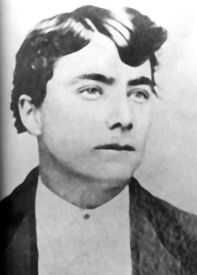
Tom McLaury.
Then John Behan, the County Sheriff, appeared, pronouncing, “Ike Clanton and his crew are on Fremont Street talking gun-talk.” Ike Clanton, the two McLaurys, Billy Clanton and Billy Claiborne, met in a vacant lot planning to bushwhack Doc Holliday, who passed that way every morning.
As Chief Marshal, Virgil agreed to go down there to break them up but contended that Behan should accompany him. Behan only laughed. “Hell, this is your fight, not mine.”
However, the Cowboys were surprised when the Earps showed up, and Doc was with them. As they made their way to the OK Corral, witnesses said that the three Earp brothers were all dressed in black with firm, mean grimaces on their faces, while Doc was nattily clad in grey and was whistling. Where the two forces finally met was 90 yards down an alley from the OK Corral. The gunfight occurred off Fremont Street between Fly’s Photo Gallery and Jersey’s Livery Stable. The Earps passed by the OK Corral but cut through the alley, where they found the troublemakers waiting at the other end.
“You are under arrest for attempting to disturb the peace,” Virgil announced. As the senior officer, he displayed only a non-threatening walking stick, giving Doc his shotgun to carry. The rustlers tightened, and Morgan and Doc simultaneously braced for action. “Hold on, I don’t want that!” cried Virgil.
What happened next was a blur, occurring in about 30 seconds. The shooting started when Billy Clanton and Frank McLaury cocked their pistols. It is unknown who fired the first shot, but Doc’s bullet was the first to hit home, tearing through Frank McLaury’s belly and sending McLaury’s shot wild through Wyatt’s coat-tail. Billy Clanton fired at Virgil, but his shot also went astray when he was hit with Morgan’s shot through his rib cage.
Billy Claiborne ran as soon as shots were fired and was already out of sight. Ike Clanton, too, panicked and threw his gun down, pleading for his life. “Fight or get out like Claiborne!” Wyatt yelled and watched Ike desert his brother, Billy, as he ran towards the door of the photography shop. But Ike then withdrew a hidden gun, firing one more round toward Wyatt before disappearing. The sound distracted Morgan enough that Tom McLaury sent a bullet into Morgan’s shoulder. Doc instantly countered, blowing Tom away with blasts from both barrels of his shotgun. Desperately wounded and dying, Billy Clanton fired blindly into the gun smoke encircling him, striking Virgil’s leg. Wyatt responded by sending several rounds into Billy.
Then it was silent, and the townspeople ran from their homes and shops; wagons were to convey wounded Morgan and Virgil to their respective homes, and doctors followed.
The 30-second shootout left Billy Clanton, Frank McLaury, and Tom McLaury dead. Virgil took a shot to the leg, and Morgan suffered a shoulder wound. As Wyatt stood, still stunned, Sheriff Behan appeared, advising him he was under arrest. The Earps and Doc Holliday were tried for murder, but it was determined that the Earps acted within the law. Virgil was later terminated as marshal for his role in the homicides.
On March 18, 1882, the cowboy gang struck again while Morgan Earp played pool at Campbell and Hatch’s Saloon. A shot was fired from the darkness of the alley, striking Morgan in the back. Morgan’s body was dressed in one of Doc Holliday’s suits and shipped to the parents in Colton, California, for burial.
The entire Earp party, including Mattie, accompanied Morgan’s body. However, in Tucson, Wyatt, Warren, and Doc Holliday hopped off the train searching for Frank Stillwell, who supposedly worked in the railroad yards. The train went on to California without them.
After spotting Stillwell, Wyatt chased him down the track, filling him with bullet holes. A Coroner’s Jury named Wyatt and Warren Earp, Doc Holliday, and two other men named “Texas Jack” Johnson and Sherman McMasters as those men who had killed Stillwell, and warrants were issued for their arrest.
Earp sought vengeance on the men who shot Virgil and killed Morgan. Killing Stillwell was just his first step. Along with Doc Holliday and others, Wyatt began what is known as the Earp Vendetta Ride. Wyatt heard that Pete Spence was at his wood camp in the Dragoons, and on March 11, 1882, he and his men quickly headed out, finding not Pete Spence but Florentino Cruz. The frightened Cruz named all the men who had murdered Morgan, himself included. Earp and his men filled Cruz with bullet holes. The Earp “posse” rode out again, and on March 24, 1882, they ran into Curly Bill Brocius and eight of his men near Iron Springs. A gunfight ensued where Curly Bill was killed, and Johnny Barnes received a wound from which he eventually died.
In just over a year, the Earp “posse” along with Doc Holliday, eliminated “Old Man” Clanton, Billy Clanton, Frank McLaury, Tom McLaury, Frank Stilwell, Florentino Cruz (aka Indian Charlie), Dixie Gray, Johnny Barnes, Jim Crane, Harry Head, Bill Leonard, Joe Hill, Luther King, Charley Snow, Billy Lang, Zwing Hunt, Billy Grounds, and Hank Swilling. Pete Spence turned himself in to the authorities, where he could “hide” in the penitentiary.
In May 1882, Wyatt and Doc left Tombstone, swearing they would never return, but still vowed vengeance on Ringo, Clanton, Spence, and Swilling if they could find them. Riding their horses to Silver City, New Mexico, they sold them, rode a stage to Deming, and boarded a train for Colorado. Josie soon joined Wyatt in Denver, where they were married.
Though Mattie had traveled with the Earps to California to Wyatt’s parents’ home, at some point, she left them and ended up in Globe, Arizona, where she lived a life of prostitution. She told her friends that her husband had destroyed her life when he deserted her. Tragically, she died of a laudanum overdose on July 3, 1888, in Pinal City, Arizona.
While in Colorado, Wyatt initially worked as a private investigator and a Wells Fargo driver. He and Josie also occasionally prospected in the mountains. Sometimes, Bat Masterson would visit the couple, and the pair would see Doc Holliday, who had settled down in Leadville, Colorado, when they could.
Wyatt and Josie returned to Dodge City, Kansas, in 1883 for a time, and then he took his new bride on a tour of Texas and northern Mexico before they made their way to California.
In the meantime, Doc Holliday’s health was deteriorating badly, and he soon migrated from Leadville to Denver in the winter of 1885. Though he did not improve in Denver, he could see his old friend, Wyatt Earp, in the late winter of 1886 when they met in the lobby of the Windsor Hotel. Sadie Marcus described the skeletal Holliday as having a continuous cough and standing on “unsteady legs.”
Holliday’s health continued to get worse. As a realist, Doc was not one to believe in miraculous cures, but hoping that the Yampah hot springs and sulfur vapors might improve his health, he headed for Glenwood Springs, Colorado, in May 1887. Registering at the fashionable Hotel Glenwood, he grew steadily worse, spending his last 57 days in bed at the hotel, and was delirious for 14 of them.
On November 8, 1887, Doc awoke clear-eyed and asked for a glass of whiskey. It was given to him, and he drank it down with enjoyment. Then, looking down at his bare feet, he said, “This is funny,” and died. He always figured he would be killed with his boots on.
After spending several years in California, Wyatt and Josie spent time with the Earps in San Bernardino and Josie’s family in San Francisco. While in California, Wyatt acted as a referee in boxing matches, continued to gamble, and invested in real estate, saloons, and a racehorse
In 1897, the gold fever broke in Alaska, and the couple headed to Nome, where they opened a Saloon during the height of the gold rush. The pair also panned for their gold throughout the Yukon and did very well. They returned to California in 1901 with an estimated $80,000. However, their stay was short-lived when they heard about the gold strike in Tonopah, Nevada.
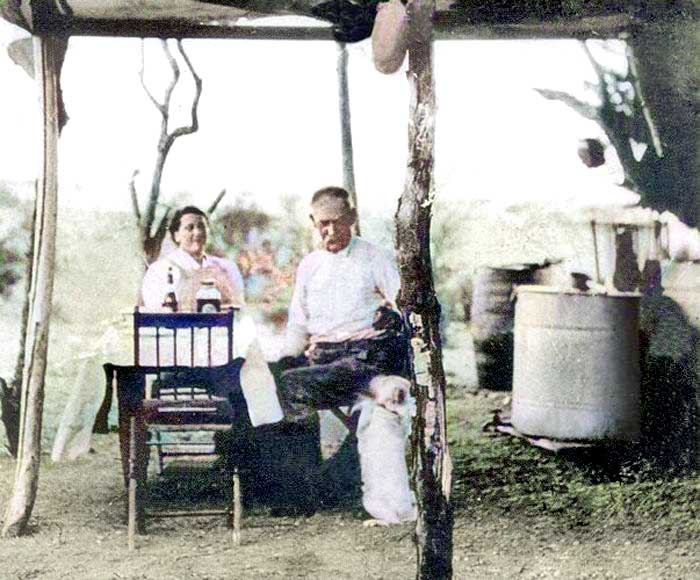
Wyatt and Josephine Earp near their mining claim outside Vidal, California, 1906.
Taking up prospecting seriously, Wyatt staked several claims in the Mojave Desert, where he discovered several veins of gold. Near Vidal, California, he discovered copper, and they spent winters in a small cottage.
Spending summers in Los Angeles, he befriended several early Hollywood actors and became an advisor for several Hollywood westerns during the silent movie days.
On January 13, 1929, Wyatt Earp died in Los Angeles at the age of 80 of prostate cancer. Cowboy actors Tom Mix and William S. Hart were among his pallbearers. Wyatt’s cremated ashes were buried in Josie’s family plot in Colma, California, just south of San Francisco. When Josie died in 1944, she was buried beside him.
Like the other Earp brothers, Virgil was taken to the family homestead in Colton, California, where he recovered from his wounds at the O.K. Corral. Later, he prospected with his wife and was still elected city marshal of Colton. He returned to prospecting with his wife, Allie, and died of pneumonia in Goldfield, Nevada, in 1905. Virgil is buried in the Riverview Cemetery in Portland, Oregon.
After helping Wyatt track Morgan’s killers, Warren served as a stage driver and did some prospecting in Globe, Arizona. He then moved to Wilcox, Arizona, and in 1900, got into a drunken fight with a cowboy named Johnny Boyet. Boyet shot and killed Warren, who was unarmed at the time. Boyet was acquitted on the grounds of self-defense, the jury believing that even an Earp without a gun was more dangerous than most men with a gun in their hand. He is buried in the Wilcox Pioneer Cemetery in Wilcox, Arizona.
When Morgan was killed, James traveled with Virgil and the Earp women to Colton, California, for Morgan’s burial. Later, he lived in Shoshone County, Idaho, before settling permanently in California in 1890. James Earp died on January 25, 1926, and is buried in Mountain View Cemetery in San Bernardino, California.
©Kathy Alexander/Legends of America, updated October 2025.
Also See:
My Friend Wyatt Earp by Bat Masterson
Tombstone – The Town Too Tough to Die
Tales of the Shotgun-Messenger Service by Wyatt Earp
See Sources.

